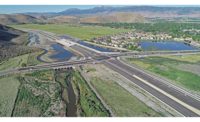Best Projects
E-470 Expansion Phase II: Best Project Highway/Bridge

Photo courtesy SEMA Construction
E-470 Expansion Phase II
Aurora, Colorado
Best Project Highway/Bridge
OWNER: E-470 Public Highway Authority
LEAD DESIGN FIRM | STRUCTURAL ENGINEER: FHU
GENERAL CONTRACTOR: SEMA/Kraemer Joint Venture
SUBCONTRACTORS: Alpha Milling; ARS Cos.; Colorado Barricade; HTM; Ideal Fence; Lumin8 Constructors; Martin Marietta; Mod Squad; Rocky Mountain Flagging; Roadsafe; Slaton Brothers; TP Enterprises; Villalobos; Zylstra Baker/SEMA
This freeway expansion project added a third travel lane in each direction along an eight-mile section of the toll road between Quincy Avenue and Interstate 70.
The CM/GC collaboration among the E-470 Authority, Kraemer, SEMA and FHU on Phase I led to the selection of the SEMA Kraemer joint venture for Phase II to further improve the corridor.
Crews widened 14 bridge structures, relocated and reconfigured the northbound E-470 on-ramps and off-ramps at Quincy Avenue and extended the High Plains Trail six miles from Quincy Avenue to the Stephen D. Hogan Parkway.
Other work improved drainage for a future fourth lane in each direction, added wildlife fencing and game ramps and overlaid the existing pavement. The improvements were delivered on time, under budget and with minimal impacts to the traveling public and with no increase in tolls.

Photo courtesy SEMA Construction
The joint venture contracting team collaborated with FHU to develop innovative designs that limited the need for temporary construction easements or property acquisition.
Coordination of trail connectivity improvements were sensitive to disturbances outside the right-of-way, and the team minimized the construction easement corridor to avoid disturbing open space areas and native vegetation.
To maximize scope and deliver a cost-effective project, the joint venture team devised multiple construction packages to begin construction concurrently with final design.
A complex traffic phasing plan accelerated the carefully timed lane closures. It also added lane capacity to the tolled interstate corridor while maintaining toll-generated income by causing only minimal impacts to the traveling public.
The overall approach streamlined the construction schedule, saving almost a year on each phase. It also minimized cost escalations for materials, reduced impacts to the traveling public and ensured the quality and long-term durability of the pavement by doing paving work during the most optimal season. Total project savings were estimated at approximately $1.2 million due to compressed construction timeframes and reduced overhead costs.




